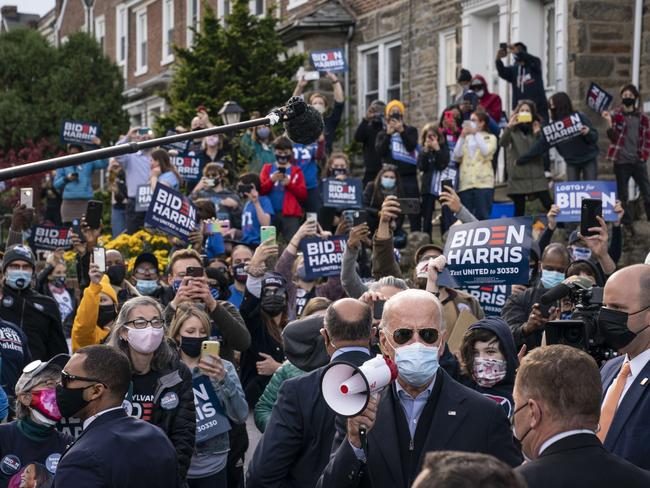Three states that will determine election
The US presidential election is expected to be determined by the counts in just three states – with analysts warning a tied vote is possible. Read what happens then.
World
Don't miss out on the headlines from World. Followed categories will be added to My News.
President Donald Trump and Democratic challenger Joe Biden are facing a long road to the White House, with seven states still left uncalled as polls closed.
US media outlets have projected wins for the Republican incumbent in 23 states including big prizes Florida and Texas, as well as Indiana, Kentucky, Missouri and Ohio – all states he won in 2016.
Mr Biden has captured 20 states including his home state Delaware and big prizes California and New York, as well as the US capital. The former vice president has flipped one state won by Trump in 2016 – Arizona, in the southwest.
Nebraska split its electoral votes between the two – four for Mr Trump and one for Mr Biden. Maine was won by Mr Biden, but so far, he has only three of the four electoral votes on offer, with the last still to be decided.

That gave Mr Biden 238 electoral votes and Mr Trump’s 213.
The prized seats of Pennsylvania and Wisconsin were yet to be called, giving both men a path to victory.
The magic number of electoral votes is 270.
In Pennsylvania – which is worth 20 Electoral College votes — Mr Trump was leading Mr Biden 55.7 per cent to 43 per cent – or by 673,000 votes, with 1.8 million still to count.
Mr Trump was leading in both Michigan and Georgia – which are worth 16 Electoral College votes each – with Mr Trump ahead 53.1 per cent to Mr Biden’s 45.2 per cent in Michigan (or 307,000 votes), and ahead 50.6 per cent to 48.1 per cent (118,000 votes) in Georgia.


There were still 1.3 million votes to count in Michigan and 1.6 million in Georgia
In North Carolina, which is worth 15 Electoral College Votes, Mr Trump was 77,000 votes ahead of Mr Biden (50.1 per cent to 48.7 per cent — with 1.9 million votes still to count.
Mr Trump was 118,000 votes (51.1 per cent to 47.1 per cent) ahead in the prized seat of Wisconsin – worth 10 Electoral College votes – with 1 million still to count
In the seat of Nevada – worth six Electoral College votes – Mr Biden was leading 50.3 per cent to 47.8 per cent – or by 27,000 votes with 378,000 still to count.
Almost 100 million Americans cast their ballots – nearly three quarters the number of those who voted in 2016.

More than 35 million of those votes in person, while more 63 million had cast by mail.
About half of states would accept ballots that will arrive post election day, as long as they are postmarked by November 3. So that means, some votes will not be counted until days after the election.
Experts predicted the election will come down to counts in three key states – Pennsylvania, Michigan and Wisconsin – with experts pointing to the possibility of a dramatic scenario in which both Mr Trump and Mr Biden claim 269 electoral college votes each – just one short of victory.
Professor Simon Jackman from the US Studies Centre rated the chances of a tied result at about 25 per cent.
The scenario arises if Mr Biden holds the existing “blue” (Democrat) states won by Hillary Clinton in 2016 but picks up Arizona, Michigan and Wisconsin, while Mr Trump holds on to Pennsylvania.
Prof Jackman warned the vote count in Pennsylvania would be very slow. Some analysts said a result in the state would not be known until Friday “at the earliest”.
“They’re not even opening the mail ballots there until tomorrow. It could drag on for a while, and almost certainly it will be subject to more litigation,” he said.
Dr Shaun Ratcliff, also from the US Studies Centre, said Mr Trump was currently leading the count in Pennsylvania, Michigan and Wisconsin, but in all three states the traditionally Republican-voting rural counties were reporting their results more swiftly than the urban counties, which usually favour Democrats.
In the event that Mr Trump picks up Pennsylvania, and Mr Biden picks up Michigan and Wisconsin – leading to a tie in the electoral college vote – the attention will swing to Maine and Nebraska, which follow different electoral college rules.
While the other 48 states have a “winner take all” approach to their electoral college votes, in Maine and Nebraska the electoral college votes can actually be split between the two parties, depending on the outcomes of their Congressional and Senate seat races.
Nebraska’s five Electoral College votes usually go toward the Republicans, but sometimes one vote will go towards the Democrats, depending on who wins the state’s second congressional district race.
And Maine’s four Electoral college votes usually go to the Democrats, but sometimes one vote will go to the Republicans, depending on one of its Senate seats.
MORE NEWS
How Trump could pull off shock victory
Originally published as Three states that will determine election

